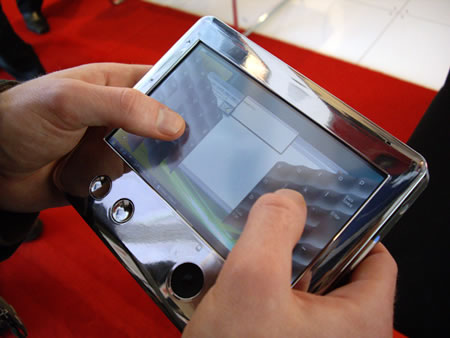Google have gone and released a browser of their own, Chrome.
Windows only at the moment, so I have not yet installed it.
Looks interesting.
Alas I have heard that Moodle does not work with Chrome, so that’s one thing I will be checking out.
Google have gone and released a browser of their own, Chrome.
Windows only at the moment, so I have not yet installed it.
Looks interesting.
Alas I have heard that Moodle does not work with Chrome, so that’s one thing I will be checking out.
Before they got real big like…
Bill Thompson has written an excellent column on the BBC news website.
Suggestions that content-hosting sites like YouTube and Flickr should review material before they were posted were especially ridiculed. Observer columnist John Naughton pointed out that at Flickr, “uploads have been between 1,400 and 4,500 images a minute”, making the task somewhat less manageable than the committee seemed to realise.
But a couple of weeks later telecoms regulator Ofcom has agreed that content delivered to mobile phones should continue to be restricted. It suggested that although the current self-regulatory scheme managed by the Independent Mobile Classification Body is working it could be made a bit stronger in some ways.

Filtering just does not work, as Bill says
web filtering does not work. The filters either let through material that we would like blocked or, far more often, block material that is perfectly acceptable
It annoys me for example that Vodafone Content Control blocks Flickr, but does not block YouTube! One day I must get those blocks removed.
From an FE perspective, filtering though blocks a lot of undesirable content, is more often used to block social networking sites, or video and image sites such as Flickr and YouTube.
I would never say that these sites are free of undesirable content, but wholesale blocking often can remove many potential assets and resources which can be used for learning.
An astute institution will realise that filtering content is only one thing that needs to be done and that educating students on using the web safely is equally if not more important than jsut relying on technological blocks.
Sony have announced a new version of their PSP portable gaming console.
Key difference will be that it will have a microphone allowing you to use it with Skype to make (internet) phone calls.
It also has a better screen.
BBC News on new PSP (and new PS3).
From Twitter, via AJ Cann’s Blog it is now possible to embed a Flickr slideshow into a webpage or a blog entry.
Alas you can not use it on a WordPress.com blog (like this is) as WordPress.com strip out something from the HTML code. Ah well.
Simply start the slideshow of your choice on Flickr, click share, and copy the relevant HTML into your webpage or blog entry, vle or similar.
You can customise the HTML so it fits the space you want better.
Ofcom have published a report, according to a BBC article, on the use of communication in the UK.
Britons are spending more time using communications services but paying less for them, says an Ofcom report.
Every day in 2007, the average consumer spent 7 hours and 9 minutes watching TV, on the phone, using the internet or using other services, it says.
Since 2002, mobile use has doubled and PC and laptop use has grown fourfold, says the watchdog’s annual review.
Though with falling costs of internet and mobile phones, though the UK is using more comms stuff, it is in fact spending less…
But the average UK household spend on communications in 2007 was £93.63 a month – a fall of £1.53 on 2006.
This certainly reiterates that our learners are well versed in the use of digital communication tools and therefore would probably be quite at home using them for learning.

Photo source.
Scribus is an open source DTP package for Mac OS X, Windows and Linux.
Scribus is an open-source program that brings award-winning professional page layout to Linux/Unix, MacOS X, OS/2 and Windows desktops with a combination of “press-ready” output and new approaches to page layout. Underneath the modern and user friendly interface, Scribus supports professional publishing features, such as CMYK color, separations, ICC color management and versatile PDF creation.
Could be an alternative for InDesign, Quark and of course Publsher. Scribus website.
One of the devices that many MoLeNET projects found really useful for creating video for mobile devices was the small pocket flash based MP4 cameras such as the Flip video camera.

These small, low cost devices allow practitioners and learners to quickly create video clips which can then be easily uploaded to a VLE or blog or similar.
In a recent Guardian column, Stephen Fry wrote about the merits of the Flip:
Video. Your mobile phone might be capable of it, your compact digital camera almost certainly is and there are dozens of dedicated camcorders available that can write moving picture information to all kinds of media at all kinds of qualities for all kinds of money. Why, then, a basic handheld video camera that can do nothing else? a) What is the point? and b) Where is the market? The answers, refreshingly, are a) Fun and b) The young.
I don’t have a Flip, though I know others that have similar devices and echo Stephen’s comments. Personally I have been using HD cameras such as the Panasonic HDC-SD5 which takes some excellent quality video which is captured to an SD card.
Key question is one HDC-SD5 worth three to four Flips?
The answer depends on the use of the video you shoot.
For quick video capture which needs to be uploaded quickly online, then the Flip wins out.
If you need to edit the video, or want to show the video through a data projector then the HD video has to the first choice.
Which would you choose and why?
Photo source.
It’s the summer break here in the UK for FE, so as a result I expect posts to this blog to be less over August. However I will be back in September.
It would appear Toshiba (the originator of the classic Libretto small form factor laptop) is looking at the mini-book market.
From PC Authority:
The notebook giant is planning an ultra low-cost portable to join the ranks of the Eee PC and MSI Wind (though not necessarily a direct competitor, they say).
Officials won’t reveal details, yet, but they are showing a prototype of a device they’ve created to spur development ideas. The tiny handheld (shown in the main pic below) reminded us more of a UMPC than a notebook, with the keyboard ditched in favour of a touchscreen keyboard.

Looks interesting, more like the Nokia N810 rather than a true UMPC
.
For me Windows Vista is not really the best operating system for these internet devices, a bit too much power and as a result poor battery life and lots of heat!